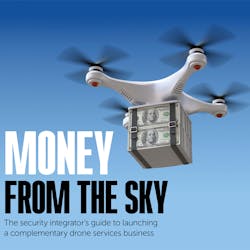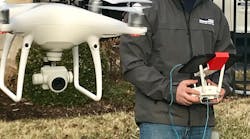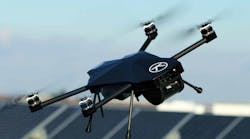Are you ready for a new kind of recurring revenue? With the world poised on the precipice of converting commercial drones into true sources of revenue, forward-looking security integrators should be getting ready for the challenge. In fact, the data collected on a single drone-based service run can significantly add to profits. There is literally money in the air.
The drone industry is expected to grow to more than $82.1 billion in annual revenue by 2025, according to The Economic Report. While this is largely driven by the consumer market, global commercial unmanned aerial vehicle (UAV) revenues will reach $15B in 2022, growing on average by 50 percent per year over the next five years. Although UAV hardware will remain a substantial market, an Interact Analysis report found that UAV services will be the biggest driver of revenue growth over the next five years – predicting that revenues generated by UAV services will exceed $8B by 2022, which is nearly double the revenue coming from the UAV hardware itself.
These services are driving the business opportunity from the security angle. A single drone mission can gather data that can be monetized by security integrators in many ways, including perimeter security design; a city or state’s mapping data; potential civil engineering improvements like dams, washes and flood zones; inspection of critical transportation infrastructure such as bridges, as well as solar panels or building roofs; and the list goes on.
“Drivers wanted” signs will soon be replaced by “Licensed Drone Pilots Needed.” A different skillset will be desired, and those remote pilot gamers and radio-controlled vehicle enthusiasts may finally get paid for their often-expensive hobbies.
But first, get to know your resources. Understanding your own drone program’s needs is a critical start, followed by identifying needs by company, market, city, state and federal authorities having jurisdiction (AHJ). You can become a pilot or add one to your team, acquire a license, get insurance, and then start focusing on markets and leveraging the new drones as a service.
If you are already offering video surveillance systems, you may be tempted to focus your drone-related business on detection or so-called anti-drone technologies; in fact, I head an ISC West attendee remark that “there are almost as many anti-drone systems in the exhibit hall as drones.” Anti-drone tech will be the topic of the next article, but here I will focus on drones and services and the markets where they are most appropriate.
Getting Started
Setting up a drone sale and/or service business is similar to setting up a dealership or franchise for a traditional security product line. Partner with a manufacturer and focus on a few products that you can speak confidentially about to an end-user. As it is with any security products, training and expertise are the keys.
As far as compliance, Part 107 of the Federal Aviation Regulations (https://www.faa.gov/uas/media/RIN_2120-AJ60_Clean_Signed.pdf) cover a broad spectrum of commercial uses for drones weighing less than 55 pounds. Security integrators should be familiar with these FAA regulations; and all drone pilots will need to pass testing to become FAA Part 107-certified. Further, training pilot(s) should focus on several recommended and required items:
- Imaging – how to get the best photos and videos from your drones;
- Training on specific flights and missions for your target market(s);
- FAA-approved flight training, which is available online; as well as
- Drone manufacturer-specific pilot certification (be ready for the next big changes in the drone industry, like Fixed Wing, BVLOS and Drone in a Box, which will require more certification and training).
Beyond training and compliance, commercial drone liability insurance is a must-have. The insurance typically covers the expenses of accidental injuries or property damage resulting from drone use. This includes bodily injury, disability, and even death resulting from a drone crash (it does not cover the drone itself). Drone liability insurance providers may sell a specialty policy specific for drone use or as part of a larger commercial general liability policy. Specialty drone insurers include companies such as Global Aerospace and Aerial Park, but security integrators should first check with their general liability insurance provider.
Additionally, marketing the new drone services is critical, because of the newness of the offerings. Create a custom landing page on your website optimized to create leads coming from your location – meaning your business will show up on top of Google when someone searches for drone services in your service area(s). Be sure to convey aspects of your service and of the product that are crucial to the end user’s needs.
Choosing a Drone
When it comes to choosing a manufacturer partner or line of drones for commercial use, UAV Coach (http://uavcoach.com) is a great resource. The website, launched in 2014 by Alan Perlman, is a terrific information and training source for drone professionals and enthusiasts. In addition to product features, the site includes the Drone Pilot Ground School, a test prep course for U.S. drone pilots that helps prepare them for the FAA Aeronautical Knowledge Test.
The site recently outlined “The Top Professional Drones for Serious Commercial UAV Pilots” at https://uavcoach.com/professional-drones.
DJI is one of the top consumer drone manufacturers, known mainly for its Mavic series – the quintessential drone for new to intermediate pilots and videographers. The list includes several DJI drones, and its Phantom 3 Model is also making significant news.
Other manufacturers cited by UAV Coach include Yuneec, which created the first commercially successful, ready-to-fly fixed wing RC airplane and transitioned into video quadcopters such as the Typhoon H520; and the “collision-tolerant” Elios drone line from Swiss manufacturer Flyability.
Other drone manufacturers and suppliers are marketing to the security industry. At ISC West this year, exhibitors included:
- Hoverfly, which uses a tether to connect a UAV to a mobile ground station – meaning there is no need for recharging batteries and thus, infinite flight time;
- Nightingale Security, which offers a fully-autonomous drone-infrastructure system – including base stations, drones and software – based on a monthly service fee/annual contract (aka Robot as a Service (RaaS) model); and
- Asylon, which designs, engineers and manufactures the DroneCore System – which offers pre-programmed autonomous drone patrols, automated response to IoT alarm triggers, and more.
Additional notable manufacturers worth researching include Kespry, Autel Robotics, Insitu, Delair, EHANG, Aeryon Labs and CyPhy.
Additionally, do not forget about products that can help workflow, such as the Davteck Copilot six battery charger with SIM and SD Card that charges and uploads drone-acquired data to an online service like DropBox automatically.
Once you have chosen the technology, hired and/or trained your pilots and made sure your company is ready for launch, the business of choosing a customer set begins. There are several markets and industries where the data collected by drones becomes an invaluable tool – it is your job to collect and provide that data.
Primary Use: Maintenance and Inspections
The construction market – which includes building inspection, new construction and surveying of infrastructure such as cell towers and bridges – is forecast as a major driver of UAV industry growth; in fact, it is predicted to become the single largest drone services application by 2022. All aspects of construction – from design to final product – depend on highly accurate site data, whether it is a road, bridge, commercial housing project, industrial development or resort or planned community.
Drone imagery gives the contractor a quick and accurate record of the actual surface at the start of construction to compare with the plans used in the bid documents. It saves time, money, and materials to know about problems early in the process; also it makes progress payments more easily justified, providing imagery to prove progress. As for project management, drone images mean that each step can be evaluated and improved, progress tracked, and options considered, using pre- and post-construction imagery.
As reported in the recent Security Business article, LiDAR vs Radar Toe-to-Toe (Oct. 2018, www.securityinfowatch.com/12431036), LiDAR-based 3D imagery offers impressive features that the construction market can leverage when used by a drone, including:
- Progress monitoring – A comprehensive birds-eye view to see where the project is at. Staging, related to the current progress of the project, is better shown with pictures then sketches on plans;
- Asset management, including the location of trucks and cranes (crane position is also important, as there have been many crane accidents of late); and
- Volumetrics, the secret of success to drone services in construction – it contributes directly to value engineering and significant cost savings, answering questions such as how much dirt is needed to fill a hole, or how much gravel is left in a pile.
Inspections: While home roof inspections via drone involve the visual search for leaks, proper flashing, and the condition of the shingles and chimney, it is a thermal inspection that may prove to be the most meaningful. Whether it is on a home or commercial property, roof thermography is done when there is little or no solar load on the roof. What used to take days to find heat loss or air conditioning efficiency can be done with a thermal imaging-equipped drone in hours; however, flying after sunset may require a special waiver. Also, flying at a height to get the whole roof will most likely not be close enough to view details.
A trending use is the detection of photovoltaic (PV) panels about to fail. In a previous issue of Security Business, I reported on the often unexpected shortening of PV panels and the rapid decrease of output after the 10th year (10 Technology Game-Changers for 2019, www.securityinfowatch.com/21038790). A normal operating PV panel has a heat signature that increases prior to failure. If the solar farm has millions of PV modules, UAVs fitted with high-resolution thermal-imaging equipment can fly over the facility and quickly detect the panels that are about to fail.
Beyond regular maintenance; drone inspection can confirm proper installation of roof materials during construction. The cost of inspection can often be included in the project price, so almost all new construction is a drone inspection business opportunity.
Wind and solar farms also require a great deal of inspection for maintenance. Turbines are complex, and technicians cover everything from the tip of the turbine blade to the tower that supports the nacelles. By using a UAV for these inspections, there is no need to place personnel in dangerous positions requiring high-lift buckets, slings and climbing harnesses.
Additionally, indoor drone inspections have become an enormous ROI booster for breweries, grain harvesters, coal plants and energy companies who own and operate industrial assets. Indoor inspection drones are not under FAA or airspace requirements. There is zero or limited GPS inside a building, under a vehicle bridge or inside a tank, so the inspection drone relies on lasers and sensors to produce a flight path and remain stable.
Outdoor drones look down; indoor drones have a forward- or upward-looking camera to inspect welding, a stack, a boiler and often have a protective cage around it. Meant to go inside tight spaces, they have LED lighting at various angles. If you put the lights in the same direction as camera, cement dust or coal dust will reflect back to the imager. Pitting, cracks, corrosion can be automatically detected. Within 10 seconds, you are in place performing a tank inspection, as opposed to power lines, so the flight time is shorter.
The Energy Market
Utilities are another of the most promising markets, alongside building and construction. Energy facility personnel constantly gather data and monitor functionality, including reviewing perimeters, evaluating spills or hazardous leaks, identifying potential threats and responding quickly if an emergency occurs. They also must inspect oil and gas pipelines and oil rigs and refineries, power lines and renewable energy assets. UAVs can lower operating costs and reduce risk.
A drone’s ability to fly pre-saved missions via modern fully automated ground stations allows for time-lapse photos of perimeters and large spaces. Using the UAV, facilities personnel can take HD photos, HD video or IR video to identify heat signatures or problems. It can also be used for training, perimeter management and surveillance operations.
Nuclear tank inspections are critical and both outdoor and indoor drone uses are becoming a critical tool for inspectors.
Gas leak detection is another continuing goal; in fact, Pacific Gas and Electric Co. (PG&E) recently partnered with NASA’s Jet Propulsion Laboratory (JPL) to adapt a methane sniffer developed for the Mars rover for gas pipeline leak detection work. The sniffers will enable UAVs to fly over pipelines inspecting for leaks at maximum flight speed of 60 mph.
All types of pipelines in power and utilities, including gas, coal, power, chemical and refineries, are in constant repair, and a drone system can dramatically reduce the manpower needed to monitor and maintain pipelines by allowing operators to cover vast expanses of pipelines and transmission lines in a fraction of the time using HD photos and HD video.
More Target Markets
Here’s a look at other potential customers who could benefit from drone-based services provided by a security integrator:
Corrections: Prisons must review perimeters, evaluate all aspects of the prison population, identify potential threats, perform crowd control and respond quickly if an incident occurs. The UAS offers prison personnel the ability to quickly assess perimeters and take HD photos or IR video to identify heat signatures of inmates – all from a distance during a crisis.
Events: From concerts to patrolling above Houston’s Super Bowl LIVE event several years ago, UAVs have been life-saving devices, critical to the first responder. To service this vertical market, be sure your business is FAA certified, insured, has a valid Remote Pilot’s License, and are able to operate in Class D air space, also with a night operation waiver.
Critical Infrastructure: Many states transportation agencies are continuously introducing RFPs using drones to perform limited visual bridge inspection tasks on numerous bridges. The testing process will gauge the ability of the UAV to provide access to, as well as to photograph areas of the bridges that are typically difficult to reach via traditional means such as ropes and climbers. Upon completion of test inspection activities, an analysis of the detailed information results are performed that typically dwarf previous conventional inspections.
Site Mapping: Drones capture highly accurate HD photos and HD videos at altitudes and over large expanses using LiDAR and video. What used to take weeks is now performed in hours.
Remote areas: Managing large areas of remote and isolated land is a critical service as can benefit many vertical markets, such as remote utility substations, and even national parks, where drones enable park personnel to assess wildlife, changing conditions and perform conservation monitoring as well as aid law enforcement in monitoring heat signatures of lost individuals and poachers.
Maritime: UAVs enable pilots to cover a large view of a ship, including the hard-to-view areas over the sides of a large super tanker. This is especially timely with recent attacks on tankers traveling through areas of conflict. A two-mile perimeter at sea offers crucial time in a hostile situation when assistance is not available. With the UAV’s IR cameras and sensing payloads, leaks and other dangerous conditions are easily accessed and viewed from a safe distance.
Rail: If you were to think of a rail route as a longer pipeline, drone pilots are now able to cover vast expanses of track and crossings or roads in a fraction of the time, often saving lives. With AI and object recognition, even small objects that pose a derailing threat can be detected. Also, passenger car behavior at rail crossings can also be monitored to justify enhanced crossing barriers and signals.
Real Estate: According to MLS statistics, homes with aerial images sold 68 percent faster than homes with standard images. Video tours that incorporate drone footage make property stand out and attract new listings. According to the National Association of Realtors, 73 percent of homeowners say that they are more likely to list with a real estate agent who uses video to market their home; however, only nine percent of agents actually create listing videos themselves – an opportunity for the systems integrator. The UAS can be used in all areas of real estate, including commercial, residential and industrial properties. Using the UAS, real estate professionals can create promotional videos, photos and unique shots that normal camera aspects cannot capture. The easy-to-use video and photo platform enable properties to stand out, providing views that are typically shown with computer animation or costly helicopter rentals. The remote VLOS platform is useful for new planning, zoning and large developments, with multiple height pictures and elevation views.
Transportation: Providing timely information on highway traffic flow and incidents, and the transmission of this information to the appropriate decision maker, are the key requirements for improving traffic and incident management. The UAV, when equipped with HD video cameras and/or other sensors, can provide timely information regarding traffic incidents while improving safety and security for the public.
Agriculture: In the agriculture vertical, the drone can accurately recreate the same pattern during all seasons, providing invaluable data for land and soil management. Using HD video, HD photos and IR cameras allows for detailed analysis and recording. With photo rendering software, 3D maps and topography can be used in conjunction with time-lapse photos to create highly detailed maps for erosion, flood mapping and other critical aspects of land management.
Internal Uses
From an integrator’s perspective, drones can provide cost- and time-saving benefits that range from eliminating trial and error to saving on labor costs. Specifically, drone technology has proven beneficial in supporting sales and especially for surveying sites for deployment and installation planning.
Drones, in fact, can play a key role for integrators in the site survey process. They can cut installation costs and time substantially, making the investment beneficial in the short term and long term. A $1,500 high-end commercial-use drone pays for itself with one large video surveillance site survey – which can cost as much as $1,000 a day if a bucket truck and a crew of three or more people are needed. Read more from CEO Dave Sweeney of security integrator Advantech in this article from March 2018: www.securityinfowatch.com/12400910.
For now, the first order for a savvy security integrator is to find or train a pilot on staff…and get the business ready to cash in on the money in the sky.
Steve Surfaro is Chairman of the Public Safety Working Group for the Security Industry Association (SIA) and has more than 30 years of security industry experience. He is a subject matter expert in smart cities and buildings, cybersecurity, forensic video, data science, command center design and first responder technologies. Follow him on Twitter, @stevesurf.







